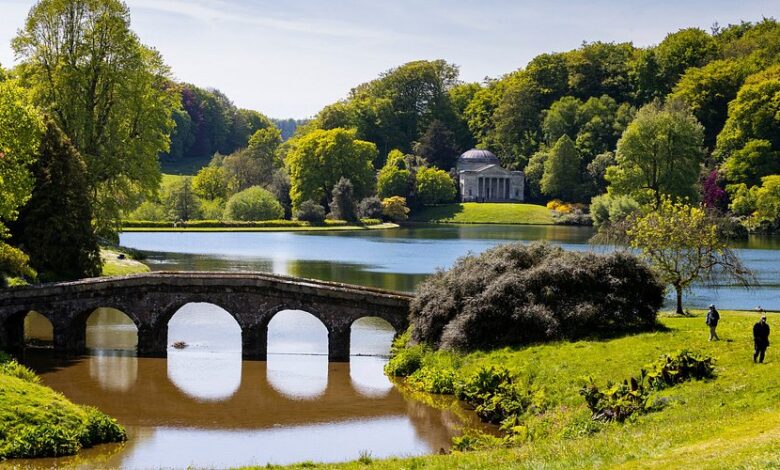Stourhead

Stourhead: England’s Elegant Garden of Dreams
Introduction
Nestled in the Wiltshire countryside, Stourhead is more than a stately home — it is a masterwork of garden design, history, and natural beauty. Visitors come not only to see the house and art collection, but to stroll through the legendary landscape garden, where lakes, temples, grottoes, and vistas evoke a poetic journey. In this article, we explore the origins, features, and visitor experience of Stourhead in a clear and engaging way.
Origins and History
Early Ownership
The lands that became known as Stourhead were held by the Stourton family for many centuries before being sold in 1717. That year, Stourhead passed into the hands of Henry Hoare I, heir of the prominent Hoare banking family.
Building the House
Once Henry Hoare I had acquired the property, he commissioned the architect Colen Campbell to demolish the existing manor and design a new villa in the Palladian (Neo-Palladian) style. The construction of the new Stourhead House took place between about 1721 and 1725.
Over the years, successive Hoare generations expanded the house — adding wings, a portico, gallery, library, and decorative interiors. (National Trust) However, tragedy struck in 1902 when a fire gutted the central block. Fortunately, many heirlooms were saved, and the house was restored in almost identical style by 1907.
In 1946, the last Hoare owner formally gave Stourhead to the National Trust, ensuring its preservation and public accessibility.
The Gardens: A Romantic Landscape
Inspiration & Design Philosophy
What makes Stourhead particularly celebrated is its 18th-century landscape garden. Designed primarily under Henry Hoare II (often called “Henry the Magnificent”), the gardens took shape between circa 1741 and 1780.
Hoare’s inspiration came from painting — especially the works of Claude Lorrain, Poussin, and Gaspar Dughet — and the idea was to create a living pastoral composition. (History Hit) The layout is intended to feel like a visual journey: one moves from one framed view to the next, with architectural features acting as focal “stages” in the scene.
Key Features & Architectural Elements
As you wander through Stourhead, many iconic features await:
- The Lake – An artificial waterbody created by damming a stream, the lake is central to the garden’s layout.
- The Palladian Bridge – A five-arched, ornamental bridge that looks functional when viewed from the lake’s edge, contributing to the illusion of a natural scene. (Things Helen Loves)
- The Grotto – A domed, cave-like chamber intended as a mysterious retreat, often part of the figurative “descent” in garden symbolism.
- The Pantheon – Modelled after the Roman Pantheon, this is the largest and one of the most striking garden buildings, placed as a visual anchor.
- Temple of Apollo – A circular temple on a hill, giving panoramic views over the lake and gardens.
- Temple of Flora, Temple of Hercules, and Rockwork Bridge — Other decorative structures that enrich the journey through the garden.
- King Alfred’s Tower – Though not strictly within the garden, this folly stands within the larger Stourhead estate and offers sweeping views. It was designed by Henry Flitcroft and completed in 1772 as a commemorative structure.
The garden’s layout also plays with height, foreground-background contrasts, and transitions in planting to guide the visitor’s eye and mood. (History Hit)
The Wider Estate & Landscape
The Stourhead estate is not limited to just the gardens. It spans about 1,072 hectares (approximately 2,650 acres) and includes farmland, ancient woodland, rolling countryside, and archaeological elements. (Wikipedia)
Highlights include:
- White Sheet Hill — A designated Site of Special Scientific Interest, with scenic hills, wildflowers, and archaeological remains (such as Neolithic enclosures and Bronze Age barrows). (National Trust)
- An Iron Age Hillfort — Part of the surrounding landscape offering glimpses of prehistory. (National Trust)
- Walking Trails & Wildlife — The parkland offers walking routes, birdlife, and views across the Wiltshire–Somerset border. (National Trust)
Visiting Stourhead: Tips & Highlights
When to Go
Stourhead is open to visitors most of the year. Spring, summer, and autumn are particularly rewarding when the plantings are vibrant, and the gardens are in full effect. (Visit Wiltshire) Always check the National Trust website for opening times and closures.
What to See
When visiting Stourhead, plan to:
- Start at the house to appreciate its architecture and interiors (if open).
- Walk the circuit around the lake — this is often a 1½ to 2 hour route if you take many stops.
- Pause at key architectural points: the Palladian Bridge, Grotto, Pantheon, Temple of Apollo, and other follies.
- Explore the wider estate if time allows — including trails to White Sheet Hill or King Alfred’s Tower.
Visitor Experience & Atmosphere
Many visitors describe Stourhead as magical, evocative, and deeply calming. The blend of architecture and nature is intended not just for visual pleasure but for emotional reflection. (Tripadvisor) The way that views are framed, hidden, then revealed gives a sense of discovery.
Photography is a popular pastime here: the Palladian Bridge, reflections on the lake, and views from the Pantheon are favorites.
Legacy & Cultural Significance
Stourhead is widely regarded as one of the finest examples of the English landscape garden. Its design has influenced garden makers ever since.
The estate and garden have also appeared in popular culture: films such as Pride and Prejudice and Barry Lyndon have used it as a backdrop.
Today, Stourhead is a Grade I listed building, and its gardens are also protected as a historic park of national significance.
Conclusion
In short, Stourhead is not just a house, but a vivid dialogue between architecture, art, and nature. Every step through its gardens is part of a carefully orchestrated visual poem. Whether you’re a lover of gardens, history, architecture, or simply seeking tranquility in beautiful surroundings, Stourhead delivers on all fronts.
Here’s an original FAQ section about Stourhead, written in clear, easy English with your keyword Stourhead used naturally throughout — perfect for SEO and reader engagement:
Frequently Asked Questions (FAQ) About Stourhead
1. What is Stourhead famous for?
Stourhead is famous for its stunning 18th-century landscape garden, often called one of the most beautiful gardens in England. It features a large lake, classical temples, bridges, grottoes, and picturesque walking paths surrounded by lush greenery and reflections.
2. Where is Stourhead located?
Stourhead is located in the village of Stourton, near Warminster in Wiltshire, England. It lies close to the border with Somerset and is managed by the National Trust.
3. Who built Stourhead?
Stourhead House was built by Henry Hoare I between 1721 and 1725. The garden was later designed and developed by his son, Henry Hoare II, also known as Henry the Magnificent.
4. Who owns Stourhead now?
Today, Stourhead is owned and maintained by the National Trust, which took over the property in 1946 to preserve it for future generations.
5. What can visitors do at Stourhead?
Visitors can enjoy walking around the scenic lake, exploring the temples and grottoes, visiting Stourhead House, and hiking across the wider estate. There are also cafés, shops, and seasonal events for families and tourists.
6. What are the main attractions in the Stourhead garden?
The main highlights include:
- The Palladian Bridge
- The Temple of Apollo
- The Pantheon
- The Grotto
- The Temple of Flora
- The King Alfred’s Tower
Each structure offers a unique viewpoint of the landscape and tells part of Stourhead’s artistic story.
7. When is the best time to visit Stourhead?
The best time to visit Stourhead is in autumn, when the trees display rich red, orange, and gold colors around the lake. Spring is also lovely for flowers and greenery, while summer offers perfect weather for picnics and long walks.
8. Is Stourhead open all year round?
Yes, Stourhead is open throughout the year, but opening hours for the house and garden vary by season. It’s always best to check the National Trust Stourhead website before planning your trip.
9. How long does it take to walk around Stourhead?
The full circular walk around the Stourhead lake usually takes about 1 to 2 hours, depending on how often you stop to enjoy the views and take photos.
10. Is Stourhead dog-friendly?
Yes, dogs are welcome in most areas of Stourhead’s garden and estate, provided they are kept on leads. There are also dog-friendly trails and shaded spots around the lake.
11. Has Stourhead been used in films or TV shows?
Yes! Stourhead was featured in several films, including the 2005 movie Pride and Prejudice, where the Temple of Apollo appears in the famous proposal scene.
12. How much does it cost to visit Stourhead?
Entry prices vary depending on whether you visit the garden only or the house and garden together. National Trust members can enter Stourhead for free, while non-members pay a standard admission fee.
13. Is there parking available at Stourhead?
Yes, Stourhead has a large car park near the visitor entrance. Parking is free for National Trust members and available for a small fee for other visitors.
14. Can I stay overnight near Stourhead?
There are several cottages, inns, and bed-and-breakfasts near Stourhead, some even within the estate. The National Trust also offers charming holiday cottages for short stays.
15. Why is Stourhead important?
Stourhead is considered one of the greatest examples of the English landscape garden style. It combines art, nature, and architecture in a way that influenced garden design across Europe.




